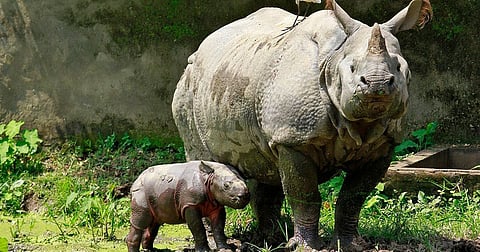
- Home
- Live Blog
- Breaking News
- Top Headlines
- Cities
- NE News
- Sentinel Media
- Sports
- Education
- Jobs

The approval by the National Board of Wild Life (NBWL) for the proposed construction of an elevated corridor through Kazrianga National Park (KNP) and Tiger Reserve is good news. Construction of the four-lane elevated corridor is crucial for sustaining the conservation of park animals on the World Heritage Site. With vehicles passing above the animal corridors, the corridor will facilitate undisturbed movement of park animals across the National Highway 715 (old NH 37) to the highlands of the Karbi Anglong areas of the Kaziranga-Karbi Anglong landscape. The need for construction of the proposed corridor was felt to save animals from being killed in vehicle- accidents and from drowning during floods. The incidence of park animals being killed in vehicle-hit areas increases during floods, when they flee flooded grasslands to Karbi Anglong Hills for food and shelter across the National Highway. The construction of the highway led to bifurcation of the park landscape, while the unregulated and haphazard construction of dwelling houses, hotels, restaurants, and lodges for tourist accommodation led to fragmentation and encroachment of animal corridors. The problem has become acute due to the exponential rise in the number of vehicles passing through the park, which is famous for Assam's unique one-horned rhinos and also popular for the Royal Bengal Tiger, wild buffaloes, and wild elephants, in addition to rich plant and animal diversity. The proposed alignment of the 35-km-long corridor project will pass adjacent to the southern boundary of KNP and Tiger Reserve and nine identified animal corridors. The project proposal states that the existing NH-715 will be decommissioned upon completion of the proposed elevated road project, which will remove barriers to the safe movement of wild animals to Karbi-Anglong Hills from KNP grassland during monsoons for seeking refuge and food. Decommissioning of the existing highway will also remove fragmentation of the landscape and provide a homogeneous landscape by integrating Karbi-Anglong hills on the south with the National Park, reduce other indirect effects such as noise and disturbance due to vehicular traffic on the road, and discourage further ribbon development on animal corridors adjacent to the existing highway. Other benefits of the execution of the project are the strengthening of tourism development, road safety, and speeding up vehicular movement passing through the park stretch. Enforcement of speed barriers to protect animals from vehicle hits will not be there on the elevated corridor, which will facilitate barrier-free movement of vehicles and reduce travel time. The Expert Appraisal Committee of the Ministry of Environment, Forestry, and Climate Change, while granting environmental clearance to the project, laid down specific conditions for project implementation. It insisted that the alignment of roads should be such that the cutting of trees is kept bare and avoids cutting old, large, and heritage trees, if any. More than 3,000 trees are found to be falling within the proposed right of way of the elevated corridor, but the EAC underscores the need for felling the bare minimum number of trees for construction work. Another condition states that all trees with breeding grounds for herons and community nesting birds like Painted Storks, Ibis, Egrets, Pelicans, etc. will not be allowed to fall. In the presence of such trees, alignment will be required to be changed to save such trees, and the entire alignment passing near the park should be access controlled with the provision of ramps at specific places identified, considering local needs. The estimated cost of the project is Rs 7,000 crore. The smooth flow of funds for the project will depend on the timely and judicious utilisation of the released funds and adequate allocations in the Union and State budgets. The proposed construction to be undertaken in a fragile ecosystem must not be allowed to suffer from time overruns, which also lead to cost escalation. Poor progress on ongoing highway construction projects in Assam is an area of concern. Ensuring time-bound implementation of the elevated corridor project must remain the top priority for the government. While construction of the elevated corridor will go a long way in preventing the mortality of park animals migrating between grassland and Karbi Anglong Hills for forage and safe refuge, other emerging conservation threats such as the growth of invasive plants and weeds also need to be prioritised by the central and state governments. Conservation of the ecology of the Karbi Anglong hills that form part of the Kaziranga landscape is also critical to sustaining the conservation initiatives. Indiscriminate and illegal mining, resulting in the degradation of the landscape, has posed serious sustainability threats. Wildlife and environmental experts have already pressed the alarm bell, saying that if these conservation threats are left unaddressed, the environmental damage to the landscape may progress to an irreversible stage. The Karbi Anglong Autonomous Council is a key stakeholder in the conservation of Kaziranga, and the council authorities playing their role and being given the space as equal partners in the implementation of KNP and the tiger reserve management plan is crucial for achieving the desired conservation goals.